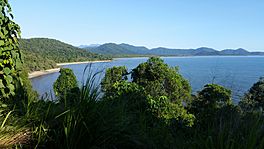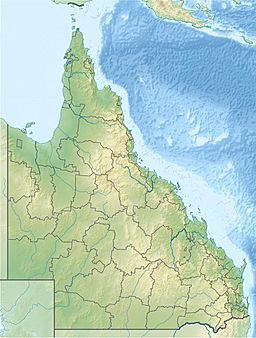Ella Bay facts for kids
Quick facts for kids Ella Bay |
|
|---|---|

Southern end of Ella Bay, looking north from Heath's point
|
|
| Location | Far North Queensland |
| Coordinates | 17°27′05″S 146°04′02″E / 17.45139°S 146.06722°E |
| Ocean/sea sources | Coral Sea |
| Basin countries | Australia |
| Max. length | 9 km (5.6 mi) |
Ella Bay is a beautiful bay located in Far North Queensland, Australia. It's found near the town of Innisfail. Innisfail is about 88 km (55 mi) south of Cairns.
Ella Bay is surrounded by mountains that are part of the Wet Tropics World Heritage Area. This area is famous for its amazing nature. Parts of Ella Bay are also protected inside the Ella Bay National Park. The ocean just off Ella Bay is part of the Great Barrier Reef Marine Park, which is also a World Heritage Area. This means the bay is surrounded by important natural places both on land and in the sea!
The Innisfail area gets a lot of rain, over 3,500 mm (138 inches) each year. It rains about 150 days a year!
Contents
History of Ella Bay
The land around Ella Bay has a long and rich history.
Traditional Owners
The Bagirbarra clan, part of the Mamu people, were the first inhabitants of the Ella Bay area. They are the Traditional Owners of this land. The Mamu people are an Aboriginal tribe with strong cultural ties to the coastal lands and waters of this region.
Before European settlers arrived, the Mamu people moved around their traditional country with the seasons. They gathered important foods like seafood, freshwater fish, game animals, and rainforest fruits. They knew how to prepare even toxic plants to make them safe to eat. Sometimes, these plants were a main part of their diet. Early visitors saw large settlements with many shelters, including long-house style buildings. There is also proof that they grew a type of yam for food.
Sadly, many Mamu people were forced to leave their traditional lands. They were moved to other places in Queensland. However, some have returned to live in the area since the mid-1900s.
Early European Contact
The first contact with Europeans happened in 1872. Survivors from a shipwreck called the brig Maria landed near Ella Bay. The local Aboriginal people helped them. They treated the survivors kindly, gave them food, and made camps for them. They even signaled a rescue boat to come ashore.
Settlers and Industries
In 1880, the first European settlers arrived. They were "cedar getters" who cut down local red cedar trees. Soon after, the area became important for growing bananas and sugar cane. These industries are still active today.
Powerful Cyclones
The Innisfail region has been hit by strong tropical cyclones.
- Cyclone Yasi hit on February 3, 2011. It was one of the most powerful cyclones to ever hit Queensland.
- Cyclone Larry hit on March 20, 2006. It caused a lot of damage to homes, buildings, and local crops like tropical fruits, sugar, and bananas.
Amazing Plants and Animals
The Ella Bay area is home to many different plants and animals. Some of these are very special:
- Southern Cassowary: This large, colorful bird is endangered. It's a very important part of the rainforest.
- Frogs: Endangered and vulnerable frog species like the Australian lace-lid, common mist frog, and waterfall frog live here.
- Crocodiles: Estuarine crocodiles are found in the waters around Ella Bay.
- Sea Turtles: Green sea turtles often use Ella Bay as a nesting site. Other threatened marine turtles might also nest here.
- Dolphins: The waters off Ella Bay are important for coastal dolphins. This includes the unique snub fin dolphin and the Indo-pacific humpback dolphin.
- Whales: Migrating humpback whales have been seen at Ella Bay.
- Dugongs: These gentle sea creatures have also been observed here. However, the seagrass beds, which are their food, are not in the best condition right now.
Ella Bay Development Plans
There are plans to build a large resort and property development at Ella Bay. This project is called the Ella Bay Integrated Resort. The people behind the project say they want to focus on being sustainable and protecting the environment. They aim to:
- Live sustainably with a very small carbon footprint.
- Collect rainwater and recycle water.
- Reduce pollution.
- Protect and improve the plants and animals in the area.
The Australian government approved the project on December 19, 2012. They added 19 conditions to help reduce harm to the environment. For example, the road to the resort will need fences and special crossings to protect cassowaries. Also, 50 hectares (about 123 acres) of habitat will be replanted.
Why Some People Oppose the Development
Many local conservationists and environmental groups are against this development. They have several concerns:
- Impact on Wildlife: They worry that having up to 5,000 more people in this wild area could harm the endangered southern cassowaries and frogs. More traffic could also put these animals in danger.
- Habitat Loss: They are concerned that critically endangered coastal rainforest will be destroyed to build roads and homes.
- Marine Life: Conservationists worry that more boats and jet skis from new residents could harm coastal dolphins and nesting marine turtles.
- Cyclone Risk: They also believe it's not safe to put so many people in an area that often gets hit by strong tropical cyclones.


